While two fighter-bomber regiments - the 19.Gv and 559.IBAP - replaced their Su-7BM with MiG-27 "Flogger-D" in the mid-1970s, two other units - the 20.Gv and 497.IBAP - abandoned their "Fitter-A" respectively for the Su-17M "Fitter-C" and the Su-17M2 "Fitter-D" during the same period. A third regiment followed suit in 1980, when the 730.APIB replaced its MiG-21SM for Su-17M. All the "Fitter" operational versions finally ended up within 16.VA units with the exception of the first iteration, the Su-17 "without suffix" alias "Fitter-C."
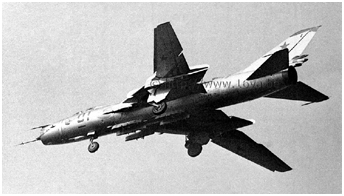
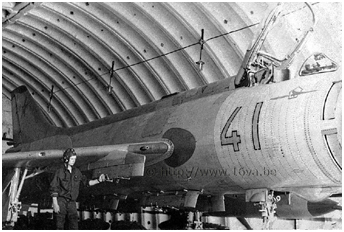 In 1965, the Sukhoy OKB modified a Su-7 (in fact a hybrid assembly of a Su-7BM and a BKL) to graft wings with variable geometry. The aim was to reduce the take-off and landing distances to be able to fly
more easily from a damaged or a deployment airfield. The airbases indeed were deemed vulnerable to tactical nuclear weapons. The experimental aircraft carried the designation S-22I
(I for Izmenyaemaya Geometriya - variable geometry). The new wing included a large, fixed part inherited from the Su-7 with the wing pivot located outboard of the landing gear and a mobile part with flaps
and leading-edge slats. The wing's deflection could vary from 30° to 63°. The new wing obviously was more complex to manufacture, 400 kg heavier, and contained less fuel than that of a Su-7B wing. The first flight took place
on August 2, 1966, and the aircraft was displayed at the Domodedovo Air Show on July 9, 1967, held for the 50th anniversary of the October Revolution, where it demonstrated its short take-off capabilities compared with a
Su-7BKL fitted with booster rockets. Since the test program of the S-22I - baptized "Fitter-B" after its appearance at Domodedovo - was positive regarding its flight characteristics and the range with the wing set at
the minimum sweep deflection, a government decree of November 1967 authorized the development and production of the Su-17 fighter-bomber (Article S-32) with a variable geometry wing.
In 1965, the Sukhoy OKB modified a Su-7 (in fact a hybrid assembly of a Su-7BM and a BKL) to graft wings with variable geometry. The aim was to reduce the take-off and landing distances to be able to fly
more easily from a damaged or a deployment airfield. The airbases indeed were deemed vulnerable to tactical nuclear weapons. The experimental aircraft carried the designation S-22I
(I for Izmenyaemaya Geometriya - variable geometry). The new wing included a large, fixed part inherited from the Su-7 with the wing pivot located outboard of the landing gear and a mobile part with flaps
and leading-edge slats. The wing's deflection could vary from 30° to 63°. The new wing obviously was more complex to manufacture, 400 kg heavier, and contained less fuel than that of a Su-7B wing. The first flight took place
on August 2, 1966, and the aircraft was displayed at the Domodedovo Air Show on July 9, 1967, held for the 50th anniversary of the October Revolution, where it demonstrated its short take-off capabilities compared with a
Su-7BKL fitted with booster rockets. Since the test program of the S-22I - baptized "Fitter-B" after its appearance at Domodedovo - was positive regarding its flight characteristics and the range with the wing set at
the minimum sweep deflection, a government decree of November 1967 authorized the development and production of the Su-17 fighter-bomber (Article S-32) with a variable geometry wing.
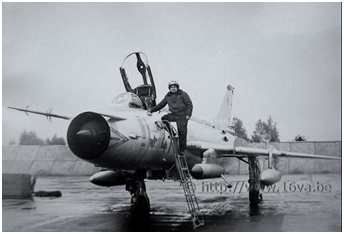
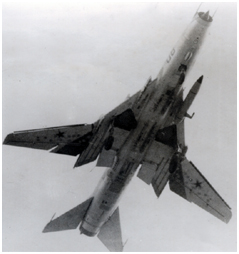 On July 1, 1969, the S-32-1 prototype took off from Komsomol'sk-na-Amure. The new aircraft was 80 cm longer and had the anti-fod device of the Su-7BM, BKL and U removed, being ultimately considered useless in operations.
The vertical fin was identical to that of the Su-7BKL with the housing of the brake parachute protruding at its base under the rudder. The dorsal fairings of the Su-7BM/BKL/U remained; however, a spine ran between the cockpit
and the vertical fin as on the Su-7U. A single boundary layer fence separated the fixed part of the wing from the mobile part on the aircraft of the first three production series (out of five). Then, from aircraft n°9221,
a second wing fence was added between it and the fuselage in order to improve longitudinal stability at high angles of attack. Two boundary layer fences were also mounted on later versions of the aircraft.
A UUA-2 angle of attack indicator was attached to the collimator. The nose wheel was larger due to the empty weight that was increased from 8450 kg for a Su-7BM to 9600 kg and, consequently, the front part of the nose wheel hatches were rounded to house it. It was possible to replace the wheels with skis for operations from unprepared grass or dirt surfaces. The engine remained the Lyoul'ka reactor of the Su-7B in its AL-7F-1-250 version; however, the speed was a little higher at sea level (1350 km/h against 1250 km/h) and identical at higher altitudes (Mach 2.1).
The Su-17 was armed with two Nudel'man-Rikhter NR-30 30mm guns like its predecessor and could carry a weapons load of 2500 kg under 6 hardpoints (like the modified "Fitter-B"); two were located under the fuselage and four
under the fixed part of the wings. The fuselage and the wing outer hardpoints could carry the 600 liter drop tanks of the Su-7 or PTB-950 and 1150. The Su-17 arsenal included S-24 unguided rockets of 240mm
attached to PU-12-40U rails, S-3K rockets of 160mm attached to APU-14U multiple rocket launchers and S-5 rockets of 57mm fired from UB-16-57 or UB-32A pods.
On July 1, 1969, the S-32-1 prototype took off from Komsomol'sk-na-Amure. The new aircraft was 80 cm longer and had the anti-fod device of the Su-7BM, BKL and U removed, being ultimately considered useless in operations.
The vertical fin was identical to that of the Su-7BKL with the housing of the brake parachute protruding at its base under the rudder. The dorsal fairings of the Su-7BM/BKL/U remained; however, a spine ran between the cockpit
and the vertical fin as on the Su-7U. A single boundary layer fence separated the fixed part of the wing from the mobile part on the aircraft of the first three production series (out of five). Then, from aircraft n°9221,
a second wing fence was added between it and the fuselage in order to improve longitudinal stability at high angles of attack. Two boundary layer fences were also mounted on later versions of the aircraft.
A UUA-2 angle of attack indicator was attached to the collimator. The nose wheel was larger due to the empty weight that was increased from 8450 kg for a Su-7BM to 9600 kg and, consequently, the front part of the nose wheel hatches were rounded to house it. It was possible to replace the wheels with skis for operations from unprepared grass or dirt surfaces. The engine remained the Lyoul'ka reactor of the Su-7B in its AL-7F-1-250 version; however, the speed was a little higher at sea level (1350 km/h against 1250 km/h) and identical at higher altitudes (Mach 2.1).
The Su-17 was armed with two Nudel'man-Rikhter NR-30 30mm guns like its predecessor and could carry a weapons load of 2500 kg under 6 hardpoints (like the modified "Fitter-B"); two were located under the fuselage and four
under the fixed part of the wings. The fuselage and the wing outer hardpoints could carry the 600 liter drop tanks of the Su-7 or PTB-950 and 1150. The Su-17 arsenal included S-24 unguided rockets of 240mm
attached to PU-12-40U rails, S-3K rockets of 160mm attached to APU-14U multiple rocket launchers and S-5 rockets of 57mm fired from UB-16-57 or UB-32A pods.
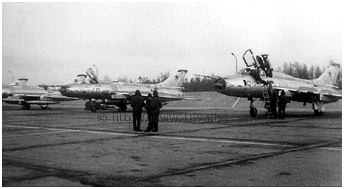
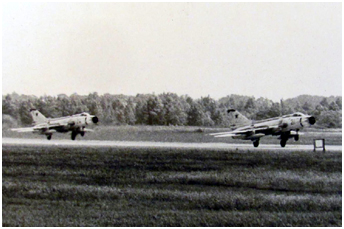 As on the Su-7, the KS-1 system automatically reduced the engine speed when firing the rockets in order to avoid its extinction following the ingestion of smoke.
The MBD3-U6-68 pylon specially developed for the Su-17 could carry either six 50 or 100kg bombs, four 250kg bombs or two 500kg bombs. Besides various types of bombs weighing up to 500kg or KMGU-1 cluster munitions dispensers,
the Su-17 could carry two SPPU-22-01 cannon pods attached to BD3-57M pylons under the fuselage or under the outer wing pylons.
The latter was designed specifically for the Su-17 and its later versions and was subsequently adopted by the MiG-27 and the Su-25. It housed a GSh-23 cannon capable of swiveling down to an angle of 30°. This pod could be oriented so as to be able to fire forwards or backwards.
The Su-17 naturally inherited the nuclear capabilities of the Su-7B. A RN-24 bomb also was attached to a BD3-56FNM pylon under the left ventral hardpoint. Two PTB-600 drop tanks were attached to the outer wing pylons in
this configuration. A PBK-2KL sight made it possible to drop special and conventional bombs during a LABS manoeuver.
An ASP-PFM-7 HUD and an SRD-5M Kvant (Quantum) rangefinder were used to fire the aforementioned armaments. When the aircraft were modified to carry Kh-23 air-to-ground missiles (from the fall of 1974),
the rangefinder housed in the nose cone was replaced by the Del'ta-N/NM radio guidance system of the missiles.
Survival of the Sukhoi depended in particular on an SPO-10 Sirena-3M radar warning receiver and R-3S or R-13M IR-guided missiles were used for self-defense.
As on the Su-7, the KS-1 system automatically reduced the engine speed when firing the rockets in order to avoid its extinction following the ingestion of smoke.
The MBD3-U6-68 pylon specially developed for the Su-17 could carry either six 50 or 100kg bombs, four 250kg bombs or two 500kg bombs. Besides various types of bombs weighing up to 500kg or KMGU-1 cluster munitions dispensers,
the Su-17 could carry two SPPU-22-01 cannon pods attached to BD3-57M pylons under the fuselage or under the outer wing pylons.
The latter was designed specifically for the Su-17 and its later versions and was subsequently adopted by the MiG-27 and the Su-25. It housed a GSh-23 cannon capable of swiveling down to an angle of 30°. This pod could be oriented so as to be able to fire forwards or backwards.
The Su-17 naturally inherited the nuclear capabilities of the Su-7B. A RN-24 bomb also was attached to a BD3-56FNM pylon under the left ventral hardpoint. Two PTB-600 drop tanks were attached to the outer wing pylons in
this configuration. A PBK-2KL sight made it possible to drop special and conventional bombs during a LABS manoeuver.
An ASP-PFM-7 HUD and an SRD-5M Kvant (Quantum) rangefinder were used to fire the aforementioned armaments. When the aircraft were modified to carry Kh-23 air-to-ground missiles (from the fall of 1974),
the rangefinder housed in the nose cone was replaced by the Del'ta-N/NM radio guidance system of the missiles.
Survival of the Sukhoi depended in particular on an SPO-10 Sirena-3M radar warning receiver and R-3S or R-13M IR-guided missiles were used for self-defense.
| ORBAT 1976 - 1994 |
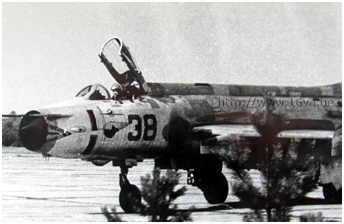
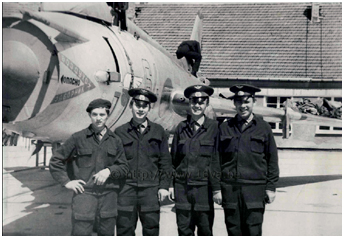 The left inner wing hardpoint (n°5) was wired to carry an SPS-141V or SPS-142V Siren' electronic countermeasures pod as on the Su-7. However, the left cannon was deactivated so as not to damage the ECM pod.
Additionally an AFA-39 camera was likely to be mounted in the fuselage behind the cockpit.
Also, starting from aircraft n°9126,a DUA-3M sensor related to the angle of attack indicator was mounted on the left side of the nose, as was the case with the MiG-21R and the following "Fishbed" versions.
Pending the entry into service of the Su-17UM two-seater trainer in 1976, the conversion of pilots had to be done with Su-7U.
225 Su-17s were built at Factory N°126 in Komsomol'sk-on-Amur from 1969 to 1973.
Despite weighing almost a ton more than the Su-7, the wider range of weapons and the capability to use shorter runways opened the way to new, more efficient versions.
The weight increase of the Su-17 according to its evolution led to a change of reactor. The re-engined aircraft designated S-32M was powered by a Lyul'ka AL-21F-3 engine with a thrust of 7800 kg
dry and 11,200 kg with the reheat engaged (against 6,800 and 9,200 kgp respectively for the AL-7F-1 reactor). This engine originally designed for the Su-24, borrowed some technology from the General Electric J79 reactor.
Two prototypes S-32M-1 and S-32M-2 flew in 1971. Their fuselage had some differences with that of their predecessor because of the smaller size of the new engine. The fairing housing two brake parachutes located at the base of the rudder inherited from the Su-7 changed its shape to become pointed - and house a single parachute. The ogive-shaped fairing which housed an antenna of the RSBN-5S radio-navigation system, as well as an antenna of the SPO-10 was moved from the top of the vertical fin to its base, above the brake parachute fairing. As for the fairings running on each side of the dorsal spine, they were removed.
The left inner wing hardpoint (n°5) was wired to carry an SPS-141V or SPS-142V Siren' electronic countermeasures pod as on the Su-7. However, the left cannon was deactivated so as not to damage the ECM pod.
Additionally an AFA-39 camera was likely to be mounted in the fuselage behind the cockpit.
Also, starting from aircraft n°9126,a DUA-3M sensor related to the angle of attack indicator was mounted on the left side of the nose, as was the case with the MiG-21R and the following "Fishbed" versions.
Pending the entry into service of the Su-17UM two-seater trainer in 1976, the conversion of pilots had to be done with Su-7U.
225 Su-17s were built at Factory N°126 in Komsomol'sk-on-Amur from 1969 to 1973.
Despite weighing almost a ton more than the Su-7, the wider range of weapons and the capability to use shorter runways opened the way to new, more efficient versions.
The weight increase of the Su-17 according to its evolution led to a change of reactor. The re-engined aircraft designated S-32M was powered by a Lyul'ka AL-21F-3 engine with a thrust of 7800 kg
dry and 11,200 kg with the reheat engaged (against 6,800 and 9,200 kgp respectively for the AL-7F-1 reactor). This engine originally designed for the Su-24, borrowed some technology from the General Electric J79 reactor.
Two prototypes S-32M-1 and S-32M-2 flew in 1971. Their fuselage had some differences with that of their predecessor because of the smaller size of the new engine. The fairing housing two brake parachutes located at the base of the rudder inherited from the Su-7 changed its shape to become pointed - and house a single parachute. The ogive-shaped fairing which housed an antenna of the RSBN-5S radio-navigation system, as well as an antenna of the SPO-10 was moved from the top of the vertical fin to its base, above the brake parachute fairing. As for the fairings running on each side of the dorsal spine, they were removed.
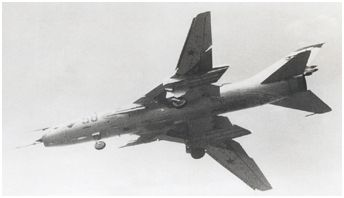
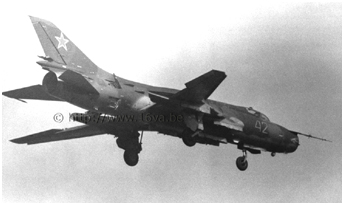 The space freed up inside the fuselage made it possible to increase the total volume of fuel carried from 3430 to 4770 liters. Two additional pylons were mounted under the forward fuselage, bringing to eight the number of
hardpoints (1). The S-32M had a range increased by 50% and its take-off run was reduced by 15%in comparison with the Su-17. Compared to the Su-7B, the range was 1.7 times greater while the bomb load was doubled.
The first serial aircraft designated Su-17M "Fitter-C" flew in December 1971. 251 aircraft were produced in Komsomolsk-on-Amur between 1972 and 1975. The Su-17M retained the ASP-PFM-7 HUD
of the Su-17, as well as the Del'ta-NM radio guidance system (the latter was located inside a Del'ta-NG > G for Gondola - external pod attached under right inner wing pylon, beginning with
the 70th series), the PBK-2KL sight and the RSBN-5S Iskra-K (Spark) short-range navigation system. The Su-17M was adapted to carry the R-60 after this new air-to-air missile was commissioned in 1973.
The armament carried reached four tons, especially because the inner wing pylons could now carry a load of 500 kg whereas only 100 or 250 kg bombs or UB-16-57 rocket launcher pods could be attached to them previously.
Thus, it was now possible to carry eight 500 kg bombs instead of four (2).
The total number of bombs attached to the MBD3-U6-68 racks (up to four, two under the fuselage and two under the outer wing hardpoints) reached up to twenty 100 kg bombs or ten 250 kg bombs could be hung under an aircraft.
Also, up to six UB-32A rocket launcher pods could be carried simultaneously.
The space freed up inside the fuselage made it possible to increase the total volume of fuel carried from 3430 to 4770 liters. Two additional pylons were mounted under the forward fuselage, bringing to eight the number of
hardpoints (1). The S-32M had a range increased by 50% and its take-off run was reduced by 15%in comparison with the Su-17. Compared to the Su-7B, the range was 1.7 times greater while the bomb load was doubled.
The first serial aircraft designated Su-17M "Fitter-C" flew in December 1971. 251 aircraft were produced in Komsomolsk-on-Amur between 1972 and 1975. The Su-17M retained the ASP-PFM-7 HUD
of the Su-17, as well as the Del'ta-NM radio guidance system (the latter was located inside a Del'ta-NG > G for Gondola - external pod attached under right inner wing pylon, beginning with
the 70th series), the PBK-2KL sight and the RSBN-5S Iskra-K (Spark) short-range navigation system. The Su-17M was adapted to carry the R-60 after this new air-to-air missile was commissioned in 1973.
The armament carried reached four tons, especially because the inner wing pylons could now carry a load of 500 kg whereas only 100 or 250 kg bombs or UB-16-57 rocket launcher pods could be attached to them previously.
Thus, it was now possible to carry eight 500 kg bombs instead of four (2).
The total number of bombs attached to the MBD3-U6-68 racks (up to four, two under the fuselage and two under the outer wing hardpoints) reached up to twenty 100 kg bombs or ten 250 kg bombs could be hung under an aircraft.
Also, up to six UB-32A rocket launcher pods could be carried simultaneously.
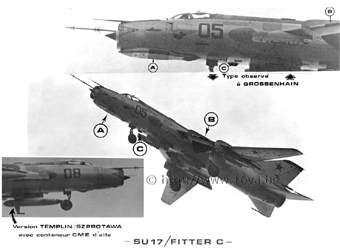
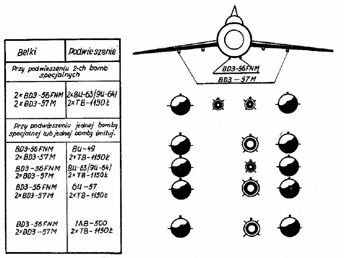 Additionally, it was possible to sequencially drop the bombs from these multiple bomb ejector racks. However, the use of such bomb racks associated with the bombs they carried considerably increased aerodynamic drag
and consequently fuel consumption. In addition to conventional bombs, the Su-17M armament included KMGU-1 and -2 cluster munitions dispensers and ZB-500 incendiary bombs. The unguided rocket types were extended
to the S-8 (80 mm - up to four B-8M1 rocket launchers) and S-25 (340 mm - two rockets) models, while the 160 mm S-3K rockets and their APU-14U launch rails were eventually withdrawn.
Article S-32MKI redesignated S-32MK or Su-20 was the export version of the Su-17M. One-thirty-eight aircraft were delivered to Egypt, Iraq, Syria, and Poland. The Polish Su-20, which carried out reconnaissance flights using KKR-1 nacelles as well as ground attack missions, also had a nuclear capability. The Soviet Su-17M carried an RN-24 bomb like on the Su-17. Technical documentation of Polish origin (above right) teaches us more about the special weapons that the Su-17M and the Su-20 could carry. Like the MiG-27, the use of two hardpoints was possible for bombs weighing 250 to 300 kg (the RN-25 - withdrawn from service in the mid-1970s , RN-28, RN-40, and RN-42). The 500 kg (RN-24 / IAB-500) were only carried individually. Unlike conventional bombs, the weight of nuclear bombs did not necessarily reflect their firepower. The transformation of a "Fitter" into a nuclear platform required 1 hour 30 minutes on average.
Additionally, it was possible to sequencially drop the bombs from these multiple bomb ejector racks. However, the use of such bomb racks associated with the bombs they carried considerably increased aerodynamic drag
and consequently fuel consumption. In addition to conventional bombs, the Su-17M armament included KMGU-1 and -2 cluster munitions dispensers and ZB-500 incendiary bombs. The unguided rocket types were extended
to the S-8 (80 mm - up to four B-8M1 rocket launchers) and S-25 (340 mm - two rockets) models, while the 160 mm S-3K rockets and their APU-14U launch rails were eventually withdrawn.
Article S-32MKI redesignated S-32MK or Su-20 was the export version of the Su-17M. One-thirty-eight aircraft were delivered to Egypt, Iraq, Syria, and Poland. The Polish Su-20, which carried out reconnaissance flights using KKR-1 nacelles as well as ground attack missions, also had a nuclear capability. The Soviet Su-17M carried an RN-24 bomb like on the Su-17. Technical documentation of Polish origin (above right) teaches us more about the special weapons that the Su-17M and the Su-20 could carry. Like the MiG-27, the use of two hardpoints was possible for bombs weighing 250 to 300 kg (the RN-25 - withdrawn from service in the mid-1970s , RN-28, RN-40, and RN-42). The 500 kg (RN-24 / IAB-500) were only carried individually. Unlike conventional bombs, the weight of nuclear bombs did not necessarily reflect their firepower. The transformation of a "Fitter" into a nuclear platform required 1 hour 30 minutes on average.
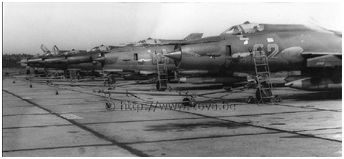
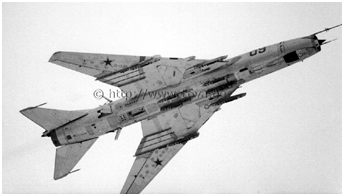 Finally, another weapon used by the Su-17M was the first operational Soviet anti-radar missile. The Kh-28, aka KS-9 "Kyle", 6 meters long and weighing just over 700 kg, was attached to a 4-meter PU-28S pylon fixed under
the fuselage centerline, which involved removing the four BD3-57M standard pylons mounted under the fuselage. In addition, an access hatch to the reactor had to be replaced by another with a recess to house the top of the vertical fin of the missile. As with other weapons such as the Kh-29 or the Kh-58, this pylon included a foldable trapeze that deployed with compressed air to force the missile away from the fuselage before it was fired.
A Metel'-A (Blizzard) pod used for detecting and determining the coordinates of an enemy radar had to be attached under the right inner wing pylon (n°6). Also, the PBK-2KL box located at the top left of the cockpit had to be dismounted and replaced by the "Blok n°2" intended for the control of the missile. The Kh-28 was equipped with a 150 kg warhead and carried 235 kg of liquid fuel. It is clear that with that type of fuel (it was the only liquid fueled aviation missile) and the contingencies related to its size made its use complicated.
Finally, another weapon used by the Su-17M was the first operational Soviet anti-radar missile. The Kh-28, aka KS-9 "Kyle", 6 meters long and weighing just over 700 kg, was attached to a 4-meter PU-28S pylon fixed under
the fuselage centerline, which involved removing the four BD3-57M standard pylons mounted under the fuselage. In addition, an access hatch to the reactor had to be replaced by another with a recess to house the top of the vertical fin of the missile. As with other weapons such as the Kh-29 or the Kh-58, this pylon included a foldable trapeze that deployed with compressed air to force the missile away from the fuselage before it was fired.
A Metel'-A (Blizzard) pod used for detecting and determining the coordinates of an enemy radar had to be attached under the right inner wing pylon (n°6). Also, the PBK-2KL box located at the top left of the cockpit had to be dismounted and replaced by the "Blok n°2" intended for the control of the missile. The Kh-28 was equipped with a 150 kg warhead and carried 235 kg of liquid fuel. It is clear that with that type of fuel (it was the only liquid fueled aviation missile) and the contingencies related to its size made its use complicated.
The first Su-17M were based in the GDR in March 1975 within the 20.GvIBAP where the first Kh-23 missile firings occured already in May. These same aircraft then joined the ranks of the 730.APIB in the spring of 1980.
The transition was much easier as the regiment was based at Gross Dölln with the 20.GvAPIB in 1980-81 because infrastructure work was underway at Neuruppin. The 20.GvAPIB that was re-equipped with Su-17M3 to replace its Su-17M also had Su-17UM and UM3 two-seaters (the latter were delivered in June 1980), which obviously helped the transition of the 730.APIB pilots on their new fighter-bomber. As for the unit's former MiG-21 models,
they returned to the USSR.
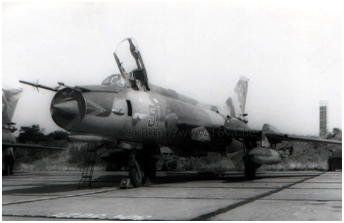
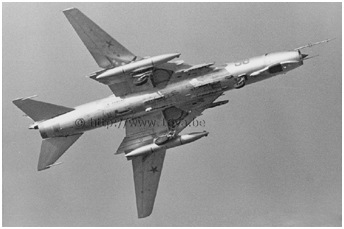 However, the association of the 730.APIB with the Su-17M was short-lived, because as early as 1982 the regiment switched to the Su-17M4 "Fitter-K." The regiment's "Fitter-D" left to join part of the 976.APIB in Kyurdamir in Azerbaijan (in March) and also a Naval Aviation unit.
However, the association of the 730.APIB with the Su-17M was short-lived, because as early as 1982 the regiment switched to the Su-17M4 "Fitter-K." The regiment's "Fitter-D" left to join part of the 976.APIB in Kyurdamir in Azerbaijan (in March) and also a Naval Aviation unit.
During the first half of 1976, it was the turn of the 497.IBAP based in Grossenhain to replace its Su-7BM. This time, it was the follow-on version of the Su-17, the Su-17M2 (Article S-32M2) "Fitter-D" - like the Su-17M - that re-equipped the regiment. Although the development of this new version initiated in 1972 was rapid, the first flight of the prototype taking place in December 1973, it proved to be laborious. The changes consisted essentially of the integration of the new equipment into the airframe of the Su-17M, the nose of which nevertheless had to be lengthened by 20 cm. New equipments included the Fon-1400 laser rangefinder - whose laser beam could be pointed in front of the aircraft at an angle ranging from 0° to -17° - and the KN-23 navigation complex, just like in the MiG-27. The space taken up by the rangefinder whose sighting window was in the nose cone, required displacement of the DISS-7 Doppler antenna in a fairing mounted under the nose, which made it possible to recognize a Su-17M2 at first glance. The diameter of the air intake vein was slightly reduced, while the fuel capacity was reduced by 200 liters. The airframe was 400 kg heavier.
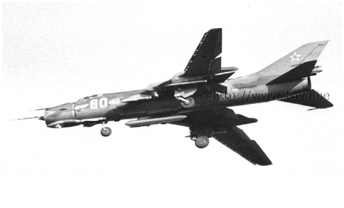
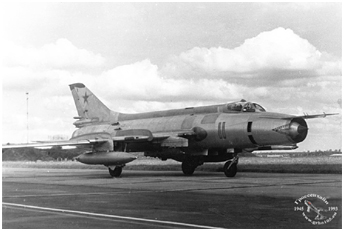 The Su-17M2 was upgraded with a new ASP-17 HUD as well as a PBK-3-17S bomb sight replacing the PBK-2KL, making more complex attack profiles possible.
In addition to the Kh-23 radar-guided missile with the Del'ta-NG pod and the Kh-28 anti-radar missile with the Metel'-A pod, the Su-17M2 could fire the Kh-25 laser-guided missile.
It was necessary to carry an SP-14S Prozhektor-1 pod attached to the right-hand pylon under the fuselage to designate the Kh-25L target. Like the Kh-23, the Kh-25 were attached to APU-68UM pylons
under the outer wing hardpoints. From 1979 on, the Kh-29L laser-guided missile was added to the Su-17M2 weaponry. The latter also required a Prozhektor-1 designation pod. A single missile was mounted on an AKU-58-1
pylon with integrated extendable arms under the left side of the fuselage. The payload remained the same as for the Su-17M, namely four tons and the nuclear capability was maintained.
Series production of the "Fitter-D" began in 1975 and ended in 1979 after 244 units had been manufactured. The export version designated Su-22 "Fitter-F" (S-32M2K) was powered by an R29 engine (precisely R29BS-300)
like the MiG-23BN.
The Su-17M2 was upgraded with a new ASP-17 HUD as well as a PBK-3-17S bomb sight replacing the PBK-2KL, making more complex attack profiles possible.
In addition to the Kh-23 radar-guided missile with the Del'ta-NG pod and the Kh-28 anti-radar missile with the Metel'-A pod, the Su-17M2 could fire the Kh-25 laser-guided missile.
It was necessary to carry an SP-14S Prozhektor-1 pod attached to the right-hand pylon under the fuselage to designate the Kh-25L target. Like the Kh-23, the Kh-25 were attached to APU-68UM pylons
under the outer wing hardpoints. From 1979 on, the Kh-29L laser-guided missile was added to the Su-17M2 weaponry. The latter also required a Prozhektor-1 designation pod. A single missile was mounted on an AKU-58-1
pylon with integrated extendable arms under the left side of the fuselage. The payload remained the same as for the Su-17M, namely four tons and the nuclear capability was maintained.
Series production of the "Fitter-D" began in 1975 and ended in 1979 after 244 units had been manufactured. The export version designated Su-22 "Fitter-F" (S-32M2K) was powered by an R29 engine (precisely R29BS-300)
like the MiG-23BN.
At Grossenhain, the personnel had followed the theoretical courses for their conversion to the regiment's new aircraft in May 1976, with the first flights taking place the following month. In August,
the unit took part in a combined arms exercise above the Lieberose polygon. The Su-17M2 remained in service with the 16.VA until the end of 1984, when the 497.APIB became the 497th Bomber Aviation Regiment (BAP) after receiving the Su-24 "Fencer-B" and "-C" previously assigned to the 116.GvBAP at Brand. The latter had been re-equiped with newer Su-24M "Fencer-D." Once overhauled at Baranovichi in Belarus, the Su-17M2 were shared between the Afghan Air Force and the 229.APIB in Birofeld (Jewish Autonomous Oblast).
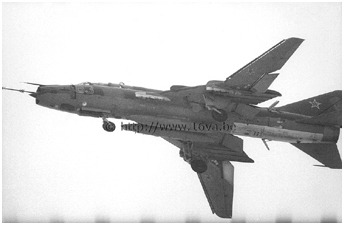
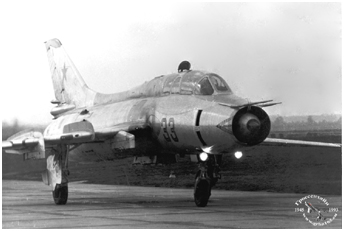 In late 1974, a government decree authorized the development of a new attack version of the Su-17 as well as its two-seater version. However, the development of the new fighter-bomber, the future Su-17M3, was
slower than that of the two-seater version. Until then, the conversion of new "Fitter" pilots had to be done on the Su-7U with its different flight characteristics and whose second cockpit was only a stopgap.
This is why the two-seater designated Su-17UM "Fitter-E" (Article S-52U) was developed as a priority. The latter, like subsequent versions of the Su-17, provided a better field of vision for the pilot.
The raised cockpit gave a steep slope of 15° to the nose ahead of the cockpit improving forward visibility and the two-seat canopy was wider than that of the Su-17M. This also gave rise to a fuselage with a slightly tilted nose section
down starting from that version. It also was from this model that the "Fitter" were equipped with Zvezda K-36D ejection seats allowing ejection with the only condition being that the speed be at least 75km/h. The presence of the second cockpit led to a decrease in the amount of available fuel (4020 liters), and the maximum bomb load was reduced to three tons. Other consequences were the mounting of a single gun on the right side, while only two hardpoints were installed under the belly, making a total of 6 hardpoints like on the Su-17. However, the Su-17UM retained the Su-17M2 weapon system (3) but wiring for guided weapons was limited to that of the use of Kh-25L and R-60 missiles. These were attached to APU-60-1 rails under the inner wing pylons. The first flight of the Su-17UM, 81 of which were built from 1976, dates to September 1975. Note the similarity of the Su-17UM with the Su-17UM3 studied in the following page. It was nevertheless easy to distinguish one from the other: to improve directional stability, the Su-17UM3 (just like the Su-17M3 and M4) had a higher tail fin whose larger extension could be observed above the rudder. Also, a small keel was mounted under the tail. The export model was designated Su-22U (S-52UK).
In late 1974, a government decree authorized the development of a new attack version of the Su-17 as well as its two-seater version. However, the development of the new fighter-bomber, the future Su-17M3, was
slower than that of the two-seater version. Until then, the conversion of new "Fitter" pilots had to be done on the Su-7U with its different flight characteristics and whose second cockpit was only a stopgap.
This is why the two-seater designated Su-17UM "Fitter-E" (Article S-52U) was developed as a priority. The latter, like subsequent versions of the Su-17, provided a better field of vision for the pilot.
The raised cockpit gave a steep slope of 15° to the nose ahead of the cockpit improving forward visibility and the two-seat canopy was wider than that of the Su-17M. This also gave rise to a fuselage with a slightly tilted nose section
down starting from that version. It also was from this model that the "Fitter" were equipped with Zvezda K-36D ejection seats allowing ejection with the only condition being that the speed be at least 75km/h. The presence of the second cockpit led to a decrease in the amount of available fuel (4020 liters), and the maximum bomb load was reduced to three tons. Other consequences were the mounting of a single gun on the right side, while only two hardpoints were installed under the belly, making a total of 6 hardpoints like on the Su-17. However, the Su-17UM retained the Su-17M2 weapon system (3) but wiring for guided weapons was limited to that of the use of Kh-25L and R-60 missiles. These were attached to APU-60-1 rails under the inner wing pylons. The first flight of the Su-17UM, 81 of which were built from 1976, dates to September 1975. Note the similarity of the Su-17UM with the Su-17UM3 studied in the following page. It was nevertheless easy to distinguish one from the other: to improve directional stability, the Su-17UM3 (just like the Su-17M3 and M4) had a higher tail fin whose larger extension could be observed above the rudder. Also, a small keel was mounted under the tail. The export model was designated Su-22U (S-52UK).
notes
(1)
While there were indeed eight hardpoints numbered 1 to 8 (1 to 6 on the Su-17), the Su-17M, like the Su-17M2, had 11 hardpoints.
The left hardpoints had an odd number and the hardpoints on the right hardpoints had an even number. Four hardpoints numbered 3, 4, 5 and 6
were under the wings and four more hardpoints numbered 1, 2, 7 and 8 were under the fuselage. So, we have end up with eight hardpoints.
To this, we must add hardpoint 0 under the center fuselage used to hang a Kh-28 missile. In addition, there were hardpoints n°1s and 2s under
the fuselage most often used to carry drop tanks. However, the BD3-56FNM pylons also were mounted there. These hardpoints were located
between hardpoints n°1 and 7 on the left and n°2 and 8 on the right respectively. See the photo showing the underside of a Su-17M2 for
additional details.
(2)
Note, however, that we should rather speak of the bombs' caliber rather than their weight. Thus, a FAB-500ShN weighed 518 kg. To this, it was
necessary to add the weight of the bomb launchers (135 kg for an MBD3-U6-68), which seriously increased the weight carried if the plane was
armed to the maximum of its capacities.
(3)
Logic dictates that in this case the Doppler is also housed in a fairing under the nose. To date, we have not found any serious information as to
the presence of the "Fon" laser rangefinder on board the Su-17UM. However, the cockpit of this version being raised, perhaps there was enough
room available to house both the rangefinder and the Doppler inside the fuselage.
 |
Plan du site - Sitemap |  |
